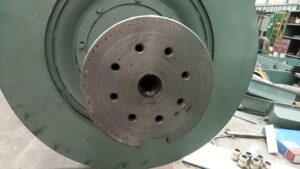Block Rotor Test of a Three Phase Induction Motor
The Block Rotor Test, also known as the Locked Rotor Test or Short Circuit Test, is one of the standard tests performed on a three-phase induction motor to determine its parameters and characteristics. This test helps in assessing the motor’s performance under conditions where its rotor is not allowed to move, simulating a blocked or locked rotor scenario.

Purpose of the Test: The primary purpose of the Block Rotor Test is to determine the following motor parameters:
- Stator winding resistance (R1): This parameter is crucial for calculating the total stator copper losses under different operating conditions.
- Stator leakage reactance (X1): It represents the opposition to the flow of alternating current caused by the stator winding’s inductance. This parameter influences the voltage drop and the power factor of the motor.
- Core loss: The test helps in estimating the iron losses in the motor’s core due to magnetic hysteresis and eddy currents.
Test Setup: The setup for the Block Rotor Test involves connecting the stator winding of the motor to a three-phase power supply. However, the rotor is intentionally blocked or prevented from moving. This can be achieved by physically locking the rotor shaft or by applying external resistance to keep the rotor stationary. The test is typically performed at rated voltage and rated frequency.
Procedure:
- Preparation: Ensure that the motor is mechanically secured to prevent any unintended movement during the test. Make sure the rotor is blocked effectively.
- Connections: Connect the stator winding to the three-phase power supply. Measure and record the line voltage and current using appropriate instruments.
- Data Collection: Record the line current (I), line voltage (V), and the power factor (pf) of the motor during the test.
- Calculation: Using the collected data, the stator winding resistance (R1) and stator leakage reactance (X1) can be calculated as follows:
- Stator Winding Resistance (R1) = (3 * V) / (I * √3)
- Stator Leakage Reactance (X1) = V / (I * √3 * pf)
Note: In these equations, V is the line voltage, I is the line current, and pf is the power factor.
Results and Analysis: The results of the Block Rotor Test provide valuable information about the motor’s stator parameters, which are essential for analyzing the motor’s performance and efficiency under different operating conditions. The stator resistance and leakage reactance are crucial for determining the voltage drop and losses in the stator winding during normal operation.
Additionally, the test also indirectly helps in estimating the core loss by subtracting the calculated copper loss from the total input power. This estimation is not as accurate as a separate core loss measurement, but it can still provide some insight into the motor’s core characteristics.
In summary, the Block Rotor Test is an important diagnostic tool for understanding the electrical parameters of a three-phase induction motor when its rotor is blocked. It aids in predicting the motor’s behavior and efficiency in real-world applications.